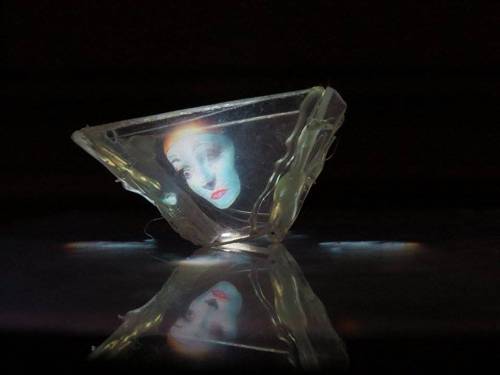
FAQ About The Role of Holography in Art and Entertainment

What is holography and how is it used in art?
Holography is a photographic technique that records the light scattered from an object and presents it in a three-dimensional form. In art, holography is used to create sculptures and installations that change appearance depending on the viewer's perspective, making for an interactive experience.

How does holography enhance live performances?
Holography enhances live performances by creating three-dimensional visual effects that can appear to be floating in space or interacting with performers on stage. This technology is often used to bring virtual artists to life or for visual storytelling, offering audiences an immersive and dynamic entertainment experience.

What are some famous examples of holography in entertainment?
Some famous examples include the holographic performances of Tupac Shakur at the Coachella Valley Music and Arts Festival in 2012, and Michael Jackson at the 2014 Billboard Music Awards. These performances have showcased the potential of holography in resurrecting deceased artists to perform virtually.

What are the cultural impacts of holography in entertainment?
Holography in entertainment often leads to new forms of storytelling and artistic expression, pushing the boundaries of visual experiences. This technology can challenge perceptions of reality, influence pop culture, and even prompt debates about ethics in using digital likenesses of deceased individuals.

What are the technical challenges involved in creating holograms for art and entertainment?
Creating holograms requires precise equipment and expertise. Challenges include capturing accurate light patterns, ensuring image stability and clarity, and managing large data volumes for projection. Engineering the necessary setups can be expensive and technically complex, limiting accessibility for some artists.

How do artists incorporate holography into their installations?
Artists incorporate holography by designing pieces that use holographic projection techniques to create interactive and shifting displays. This can involve layering holograms over physical objects or using projections in dark spaces to alter spatial perception and evoke surreal environments.

Can holography be used in interactive installations?
Yes, holography is often used in interactive installations. Artists and designers use motion sensors and other interactive technologies alongside holography to allow viewers to influence the holographic display, creating an engaging and participatory experience.

What are the ethical considerations in using holography in entertainment?
Ethical considerations include consent and the rights to use an individual's likeness, especially for deceased persons. There is also concern about authenticity and the commercialization of holographic representations, prompting discussions about artist rights and audience perceptions.

How does holography influence modern art forms?
Holography influences modern art by enabling new forms of visual representation and artistic expression. It allows for the creation of artworks that are not static, but dynamic and experiential, thereby expanding the scope of what can be achieved in visual arts.

What future developments are expected in holography for art and entertainment?
Future developments may include more accessible technology for artists, enhanced realism in holographic projections, and widespread application in virtual reality setups. These advances could broaden the possibilities for augmented performances and create more interactive installations.

How does holography affect audience engagement in entertainment?
Holography dramatically increases audience engagement by adding a layer of immersion and novelty. Audiences are often intrigued and captivated by the realism and interactivity of holographic displays, which can turn a simple performance into a memorable spectacle.

What are some limitations of using holography in live performances?
Limitations include high costs and the need for advanced technology and expertise. The setup for large-scale holographic displays can be complex and resource-intensive. Additionally, environmental factors like lighting and the audience's viewing angle can affect the quality of the hologram.

What role does holography play in digital art?
Holography plays a significant role in digital art by bridging the gap between digital and physical art forms. It allows digital artists to create immersive 3D representations that can be experienced in real space, transforming how digital art is perceived and interacted with.

Can holography be integrated with virtual reality?
Yes, holography can be integrated with virtual reality to enhance immersive experiences. This combination can create sophisticated simulations where digital elements interweave seamlessly with the physical environment, enriching interactive and experiential dimensions of VR.

How do advancements in holography impact theatrical productions?
Advancements in holography provide theatrical productions with tools to create more visually stunning and complex scenes. Holography can complement traditional stagecraft by adding virtual characters or settings, offering directors and designers new creative possibilities.

In what ways has holography changed the music industry?
Holography has allowed for the creation of virtual concerts and performances, transforming live entertainment by enabling artists to perform beyond physical constraints. It offers new ways for fans to experience music and can keep the legacy of past performers alive through virtual renditions.

Are there any notable holographic art exhibitions?
Yes, there have been several notable holographic art exhibitions worldwide. Museums such as the MIT Museum and the Museum of Holography in New York have hosted exhibitions showcasing the work of holographic artists, highlighting both artistic and technological innovations in this medium.

What is the relationship between holography and digital twinning in entertainment?
Holography and digital twinning in entertainment are interconnected as both involve creating digital replicas of physical objects or beings for virtual interactions. Digital twinning enhances holographic applications by providing detailed, accurate data and predictions for creating realistic holograms.

How accessible is holographic technology for emerging artists?
Currently, holographic technology can be costly and requires specialized equipment, making it less accessible for emerging artists. However, as technology advances and becomes more affordable, it could become a more viable option for artists looking to experiment with holography.

What are holographic projections and how are they different from traditional 3D displays?
Holographic projections create the illusion of three-dimensional objects or scenes floating in space without the need for special glasses, unlike traditional 3D displays that often rely on stereoscopic vision. This makes holographic projections more immersive and viewable from multiple angles.
